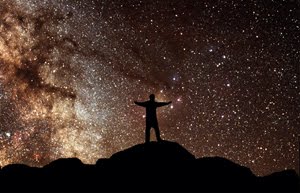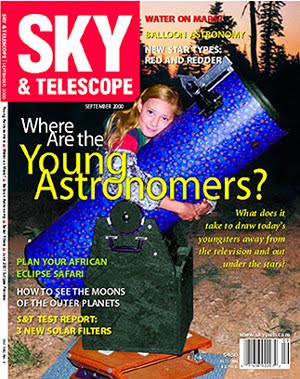Last night, Fremont Peak hosted a nice array of telescopes. Two 7" AstroPhysics sat next to the observatory, along with what I assume was a 100mm Zeiss objective in an AstroPhysics OTA. Down the hill sat a 7" Questar, 12.5" Orion dob, 12" Meade LX-200, 2 8" Meade SCTs, a 7" Meade Maksutov, 4.25" Coulter, 6" Cave and 14.5" dob.
As sunset approached, several of us began a naked eye search of the western glare for Jupiter. I thought I found it, low in the west below and to the right of the moon, but could not sight in it my scope. While I struggled, one of the women observers nailed it, low in the saddle of Fremont Peak. Looking at Jupiter, it became apparent that while we might have very good transparency, steadiness would be a problem. Soon, we began searching for Saturn. Again, the same woman was the first to locate it (in th e 6" Cave, I believe).
Darkness fell, and so did the temperatures. Soon, it was time to layer the clothing. The wind made strange sounds through the wires of the communications towers next to the Peak. To me, it sounded like a train approaching when the wind would howl.
Still, when the wind would break it was possible to get in some useful observing. Even then, the unsteadiness turned stars into planetary-nebula-like blobs for extended periods.
I started the evening by the refractor owners. My logic was that if I were going to blow my night vision looking at the moon, it should be first thing, before it was truly dark. So, I looked through the twin 7's and indeed, even though the views looked as if I was observing through water in a meandering stream, the detail was astonishing. I am quite sure the AP owners were enjoying the evening, since we saw so little of them as the night progressed.
After true darkness settled in, I began working Herschel objects in Perseus. This night I was without my friend who is working the list with me, so I was not able to check views in his 18" Obsession, nor did I have the use of his laptop computer with The Sky as my chart. So, I used my HB Astro-Atlas. I have to say I am very pleased with the HB atlas, as it is well detailed and provides a well thought-out system of symbols that lets one know key elements about the object you are viewing.
So, on to Perseus. The first Herschel object tonight would be NGC 1582, a bright open cluster about midway between Capella and Epsilon-Perseus. In a 19mm Panoptic, the cluster was rich and coarse, with many bright stars. This was an easy target.
On next to NGC 1205, another open, just 1.5 degrees away in Perseus. This object is small and glows dimly around mag 11. Compared to it's neighbor 1582's bright mag 7, this one was tough. A row of stars forming a nice line sat off to one side of the cluster, flanked by two brighter stars. This made it possible to identify the cluster (without using the LX-200's goto button).
NGC 1624 was a short hop from 1205, but this too proved a difficult object to locate. Open clusters are not my preferred target, since they are easily lost in the rich background of the Milky Way. However, after thinking several groupings were the cluster, it was obvious when I was on it since there is nebulosity involved. This cluster is small, about 5 arc minutes, and dim, roughly in the mid 10's, but a nice sight,
Now the fun was about to start. Just north of Algol, in a rich field of galaxies sits NGC 1186, my next target. At first, the field seems lacking in any notable objects. But quickly smudges begin appearing. 1186 shone at mag 13, and was obviously elongated. Its size is listed a 2.3 x 0.7 arc minutes. From there I spent time cruising dimmer galaxies all in the general area. These included NGCs 1160 (elongated galaxy close companion, mag 13.00), 1175 (edge on galaxy with bright core, mag 12.80), and finally down to Rho-Perseus to find NGC 1207 (elongated galaxy with bright core, mag 13.00).
By then it was time for a break, since Perseus now occupied Dobson's hole. The temperature was now a factor, so I agreed to honor a good natured challenge I had made once by e-mail, and participated in an arm wrestling contest. This is a great way to warm up in cold weather!
Orion was in a reasonable position, so up to (what else?) M42. What a view! My new Tele View 19mm Panoptic showed detail I had never seen. . . just incredible. M43 was so pronounced I kept calling people over to look. The extent and definition on these two objects was astonishing, and this in poor seeing conditions. Someone asked about finding NGC 891, which had been elusive for that particular observer, so with assistance from the owner of the 12.5" dob, I soon had this nice edge on in view. The dust lane was most pronounced, and the sight was a treat after all the faint stuff up in Perseus.
By now Eradinus was high (relatively) in the south. I have spent little time in this galaxy rich constellation, and decided to jump in. The first few were so large I could hardly believe it. NGC 1232 was comparatively bright and easy, classified as a barred and ringed spiral in the HB Atlas. The bar was perhaps discernable, but the ring was a real challenge. 1232 is an easy target, with a size of 8.5 x 7.5 minutes, although its mag 9.90 is spread out over its large size. Next to NGC 1187, also big and bright, is a round galaxy at mag 11 and 6.0 x 4.0 minutes.
At this point, Jay Freeman came by. Jay had arrived under the cover of darkness. A few of us thought we recognized his voice, but were unsure. Then, when we heard him remark he wasn't setting up a telescope, it was a confirmed Hacksaw Reynolds sighting (albeit an audio "sighting"). Jay eventually stopped by and asked if there was anyone crazy in the group. Being a curious person, I volunteered in order to draw out the inferred request. Jay was after M31's satellite galaxies Andromeda 1, 2 and 3. I gave up my scope and got to observe a star hopping aperture enhanced Jay Freeman in action. Soon, the faint glows of all three objects were part of the night's conquests. Jay always brings something new to a star party!
Back to Eradinus. Now, I was into parts of the constellation with galaxy clusters. NGC 1332 was very elongated and had a bright core. It was not difficult at mag 10.3 and 2.2 x 0.9 minutes. In the same field were NGCs 1325 (edge on galaxy, mag 11.6, 2 minutes), 1331 and 1319, both mag 14. After another "warm-up" break, Eradinus was getting low over the Peak, so I finished with NGCs 1395 (same field as 1303), then 1637 and 1084. Eradinus is an area that is so rich, I plan to visit it often in the winter.
Now, after midnight, a mini-van pulled into the observing area, carefully weaving its way between telescopes and other gear. Even with only the running lights on, it seems extremely bright. Who would be arriving so late on a winter night? One of our group went over and said a beautiful 20" dob was being unloaded. I went over and found the owners talking about turning on their car's headlight to aid them in collimating. WHAT! Amazing! A few of us tried using our red-LED flashlights to collimate, but this proved difficult. After some fiddling, we tried star testing. Yuck. . . a field full of bright comets! So, fearing loss of night vision, I went up the hill and brought the owner of a laser collimator down. Within 30 seconds, the scope was dead on.
On went a H-Beta filter, and the 20 gave a great image of the Horsehead Nebula. That done, and our night vision still intact, I returned to my scope to work Canis Major. Fifteen minutes later, the 20" was packing up and leaving. Maybe next time they'll remember their winter wardrobe. ;-)
So, while hunting down open clusters, and looking for NGC 2374, I happened across NGC 2359. What a surprise! Dryer's describes this nebula as: VF,VVL,VIF, size (mins) 8.0. It jumped out at me like cake frosting (upon repeated views, it did eventually seem VF to me). But, if you have not seen this one, and are in the neighborhood, it is worth viewing. It is easy to locate too, starting at Iota-Canis-Major and drawing a line through Gamma-Canis-Major, then continuing just over 4 degrees in the same direction.
By then, I was getting chilled and tired. I decided to finish my Herschel hunt the usual way, poking around at the bright stuff which, after viewing the ANT's (almost not there's), would by comparison seem to me to have the same magical qualities that first hooked me into this nocturnal habit. M42 again, 4565 filling the field even though it was low on the horizon. Up to NGC 2903 in Leo, M51 showing structure at low elevation. Up to M108 and M97 (the Owl's eyes were black pits with averted vision). Back into Leo, there were M65 and M66 in the same field, then nudged over to NGC 3628 (very nice!). Now, with Ursa Major up higher, back over to M81 and M82. . . pull the scope toward me and into view comes NGC 3077 (big blotchy galaxy). Finally, some time spent back in the belly of the lion. What a great sight, all those galaxies filling the night.
Winter observing is great. . . plenty of time to take your time and get a real night-full of astronomy. Summer may be more comfortable, but for getting your "money's worth". . . winter is the winner!











